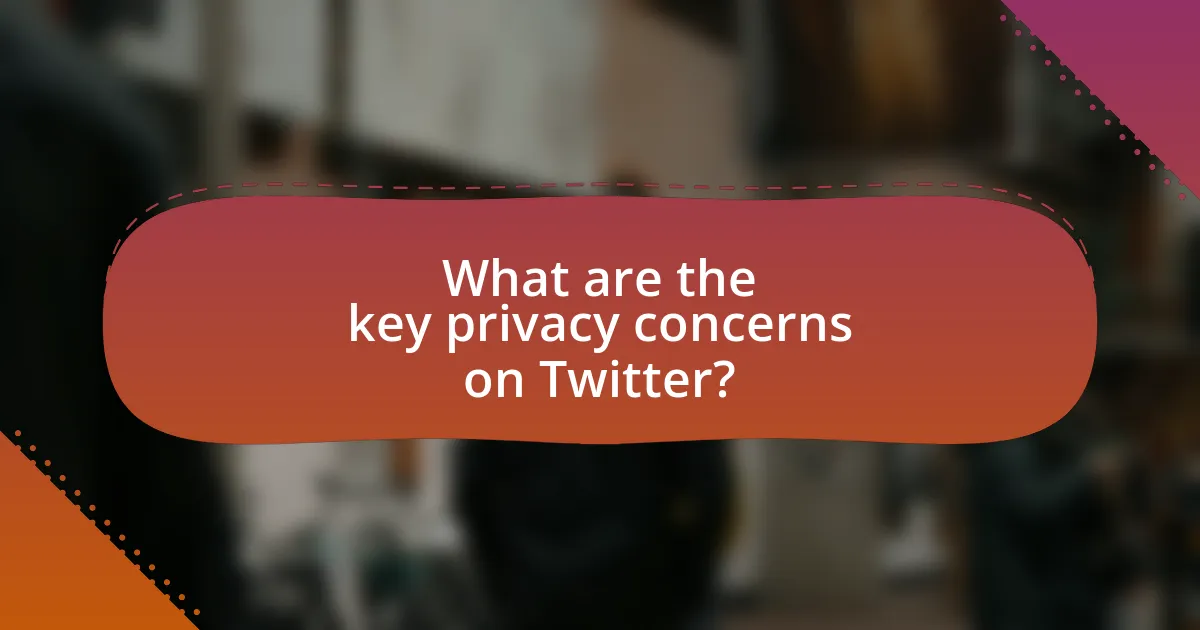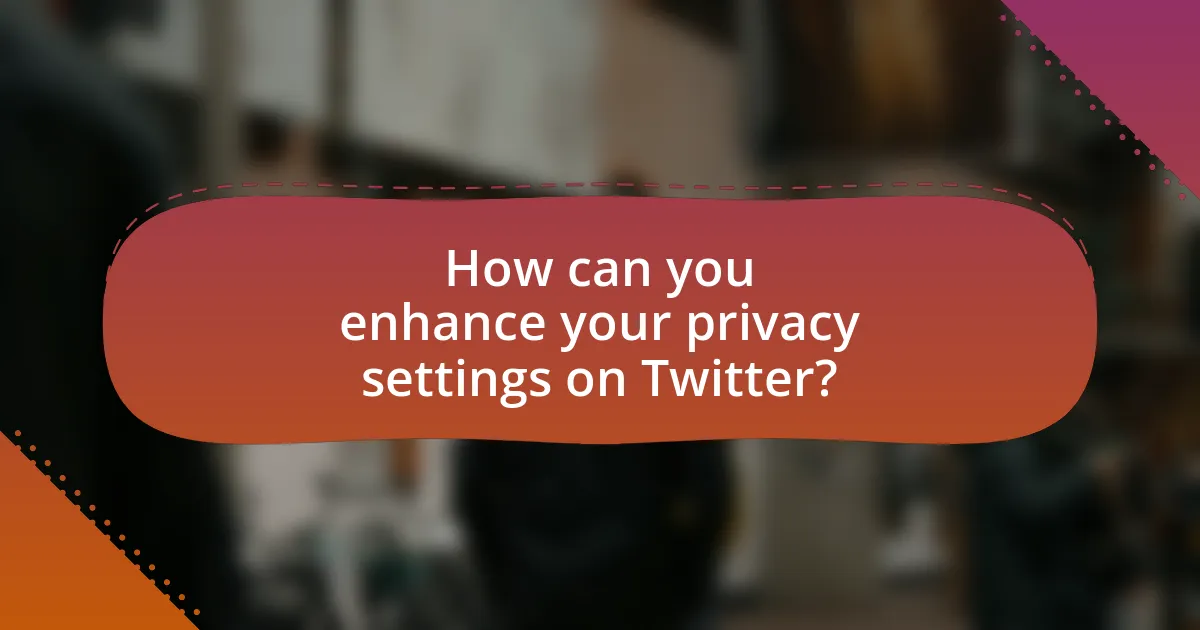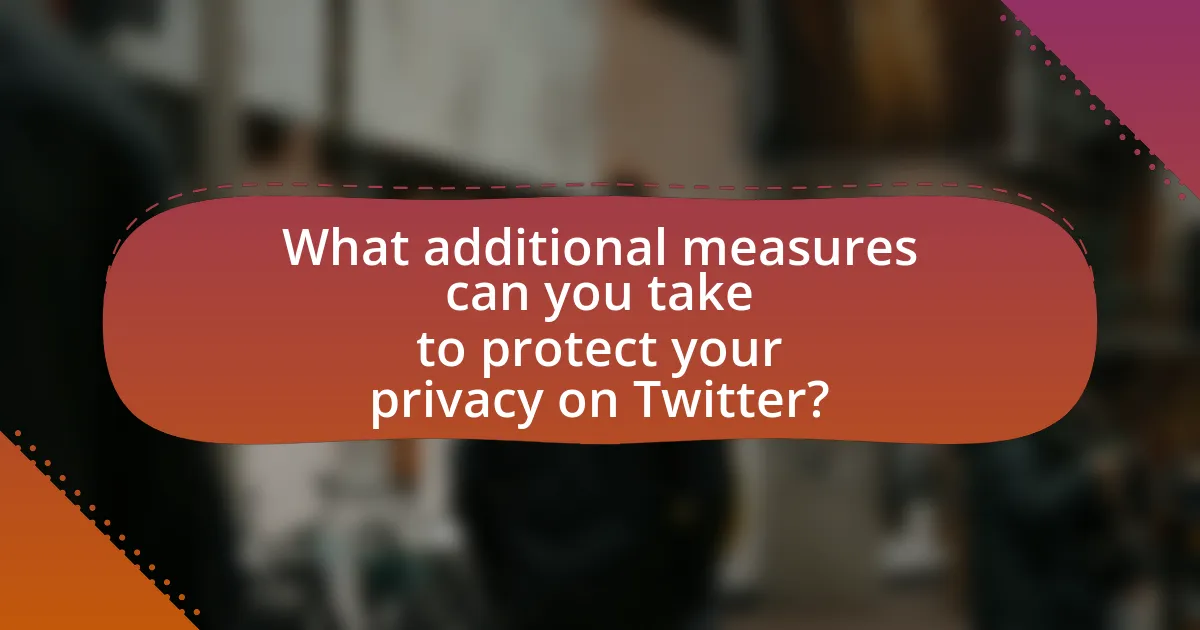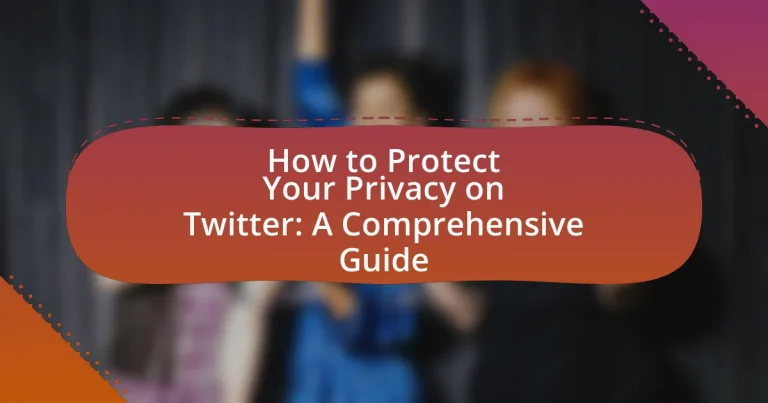The article focuses on the essential measures users can take to protect their privacy on Twitter. It addresses key privacy concerns such as data security, user data sharing, and harassment, while detailing how Twitter collects and utilizes personal data. The article outlines the types of data gathered, the risks associated with privacy breaches, and the implications of data exposure. Additionally, it provides practical steps for enhancing privacy settings, managing followers, and utilizing third-party tools to safeguard personal information. Best practices for safe tweeting and troubleshooting tips for maintaining privacy are also discussed, ensuring users can navigate the platform securely.

What are the key privacy concerns on Twitter?
Key privacy concerns on Twitter include data security, user data sharing, and harassment. Data security issues arise from potential breaches that can expose personal information. User data sharing is a concern as Twitter collects and shares user data with third parties for advertising and analytics, which can lead to unauthorized access or misuse. Harassment on the platform can compromise user privacy, as personal information may be exploited by malicious actors. These concerns highlight the need for users to be vigilant about their privacy settings and the information they share.
How does Twitter collect and use personal data?
Twitter collects personal data through user-provided information, tracking technologies, and interactions on the platform. Users provide data such as names, email addresses, and phone numbers during account creation. Additionally, Twitter employs cookies, web beacons, and similar technologies to gather information about user behavior, including tweets, retweets, likes, and follows. This data is used to personalize user experiences, target advertisements, and improve platform functionality. According to Twitter’s privacy policy, the company may also share aggregated data with third parties for analytics and advertising purposes, ensuring compliance with applicable laws.
What types of data does Twitter gather from users?
Twitter gathers various types of data from users, including personal information, usage data, location data, and content data. Personal information encompasses details such as usernames, email addresses, and phone numbers provided during account creation. Usage data includes information on how users interact with the platform, such as tweets, retweets, likes, and follows. Location data is collected through users’ device settings or when they tag their location in tweets. Content data refers to the actual tweets, images, and videos shared by users. This data collection is outlined in Twitter’s privacy policy, which specifies the types of information collected and how it is used for improving user experience and targeted advertising.
How is user data shared with third parties?
User data is shared with third parties through various mechanisms, including partnerships, advertising, and analytics services. Twitter may provide user information to advertisers to help them target specific audiences, which is often done through aggregated data rather than individual user profiles. Additionally, Twitter collaborates with analytics companies to track user engagement and improve services, which may involve sharing anonymized data. These practices are typically outlined in Twitter’s privacy policy, which details how user data is collected, used, and shared, ensuring compliance with data protection regulations.
What risks do users face regarding privacy on Twitter?
Users face several privacy risks on Twitter, including data exposure, unauthorized access, and surveillance. Data exposure occurs when users share personal information publicly, which can be harvested by malicious actors. Unauthorized access can happen if users’ accounts are compromised through weak passwords or phishing attacks, leading to potential misuse of personal data. Additionally, Twitter’s data collection practices can result in user information being shared with third parties, raising concerns about surveillance and targeted advertising. According to a 2021 report by the Electronic Frontier Foundation, Twitter collects extensive user data, including location and device information, which can be exploited if not properly managed.
How can public tweets compromise user privacy?
Public tweets can compromise user privacy by exposing personal information to anyone on the internet. When users post tweets publicly, they may inadvertently share sensitive details such as location, opinions, and personal experiences, which can be accessed and analyzed by third parties, including advertisers and malicious actors. Research indicates that 60% of Twitter users do not adjust their privacy settings, leaving their tweets visible to the public, which increases the risk of identity theft and harassment. Additionally, public tweets can be aggregated and used to create detailed profiles of individuals, further compromising their privacy.
What are the implications of data breaches on Twitter?
Data breaches on Twitter can lead to significant implications, including loss of user trust, financial repercussions, and potential legal consequences. When user data is compromised, it undermines the platform’s credibility, resulting in decreased user engagement and retention. For instance, the 2020 Twitter breach, where high-profile accounts were hacked, highlighted vulnerabilities and led to a temporary decline in user confidence. Financially, Twitter may face costs related to remediation efforts, regulatory fines, and potential lawsuits from affected users. Additionally, legal implications arise from violations of data protection laws, which can result in further penalties and stricter regulations.

How can you enhance your privacy settings on Twitter?
To enhance your privacy settings on Twitter, navigate to the “Settings and Privacy” section of your account. In this section, you can adjust various privacy options, such as making your account private, which restricts access to your tweets to approved followers only. Additionally, you can manage who can send you direct messages, control whether your tweets are discoverable by search engines, and limit the visibility of your location information. According to Twitter’s official guidelines, these settings are crucial for maintaining control over your personal information and interactions on the platform.
What steps can you take to adjust your privacy settings?
To adjust your privacy settings on Twitter, navigate to the “Settings and Privacy” section of your account. From there, select “Privacy and Safety,” where you can manage various options such as protecting your tweets, controlling who can send you direct messages, and managing your location information. These settings allow you to limit your audience and enhance your overall privacy on the platform.
How do you change your account privacy settings?
To change your account privacy settings on Twitter, navigate to the “Settings and privacy” section from your profile menu. Once there, select “Privacy and safety,” where you can adjust options such as protecting your tweets, managing who can send you direct messages, and controlling your location information. These settings allow you to customize your privacy preferences effectively, ensuring that your account is secure and your information is shared only with your desired audience.
What options are available for controlling who sees your tweets?
To control who sees your tweets, you can set your Twitter account to private, which restricts your tweets to approved followers only. This means that only users you have accepted as followers can view your tweets, enhancing your privacy. Additionally, you can use the “Protect your Tweets” feature in your account settings to limit visibility. Furthermore, you can selectively choose to block or mute specific users, preventing them from seeing your tweets or interacting with you. These options collectively provide robust control over your tweet visibility and audience.
How can you manage your followers and interactions?
To manage your followers and interactions on Twitter, utilize the platform’s privacy settings and engagement tools effectively. Adjust your account settings to control who can follow you, such as making your account private, which requires approval for new followers. Additionally, regularly review your follower list to remove any accounts that do not align with your privacy preferences. Engage selectively by responding to interactions from trusted followers and using features like muting or blocking to limit unwanted interactions. Research indicates that users who actively manage their follower interactions report a more positive experience on social media platforms, enhancing their overall privacy and security.
What are the best practices for accepting or rejecting followers?
The best practices for accepting or rejecting followers on Twitter include evaluating their profile for authenticity, assessing their engagement history, and considering mutual connections. Authentic profiles typically have a profile picture, a bio, and a history of tweets, which indicates they are real users rather than bots or spam accounts. Engaging with followers who have a history of meaningful interactions can enhance your network quality. Additionally, mutual connections can serve as a reference point for trustworthiness. By applying these criteria, users can effectively manage their follower list to protect their privacy and maintain a positive online environment.
How can you block or mute users effectively?
To block or mute users effectively on Twitter, navigate to the user’s profile, click on the three dots icon, and select either “Block” or “Mute.” Blocking prevents the user from interacting with your account, while muting allows you to stop seeing their tweets without notifying them. According to Twitter’s Help Center, blocking is a definitive action that removes the user from your followers and prevents them from seeing your tweets, whereas muting retains the follower relationship but silences their content in your feed. This functionality is crucial for maintaining privacy and controlling your online interactions.

What additional measures can you take to protect your privacy on Twitter?
To protect your privacy on Twitter, you can enable two-factor authentication (2FA) to add an extra layer of security to your account. This measure significantly reduces the risk of unauthorized access, as it requires a second form of verification beyond just your password. According to Twitter’s own security guidelines, enabling 2FA can help prevent account takeovers, which are a common threat on social media platforms. Additionally, you should regularly review and adjust your privacy settings, such as limiting who can see your tweets and who can send you direct messages, to further safeguard your personal information.
How can you use third-party tools to enhance privacy?
You can use third-party tools to enhance privacy by employing VPNs, encrypted messaging apps, and privacy-focused browsers. VPNs, such as NordVPN or ExpressVPN, encrypt your internet connection, masking your IP address and preventing tracking. Encrypted messaging apps like Signal or Telegram provide end-to-end encryption, ensuring that only the intended recipients can read your messages. Privacy-focused browsers, such as Brave or Firefox with privacy extensions, block trackers and ads, further protecting your online activities. These tools collectively reduce the risk of data exposure and enhance your overall privacy on platforms like Twitter.
What are the most recommended privacy-focused tools for Twitter?
The most recommended privacy-focused tools for Twitter include TweetDeck, which allows users to manage multiple accounts and customize their feeds while maintaining privacy settings, and Privacy Badger, a browser extension that blocks trackers and enhances user privacy. Additionally, using a VPN can help encrypt internet traffic and mask IP addresses, further protecting user identity while accessing Twitter. These tools are widely recognized for their effectiveness in safeguarding user privacy on social media platforms.
How do these tools help in managing your Twitter privacy?
These tools help in managing your Twitter privacy by providing features that allow users to control their data visibility and interactions. For instance, privacy management tools enable users to adjust their account settings, such as making their profiles private, which restricts access to their tweets and personal information to approved followers only. Additionally, these tools often include options to block or mute accounts, preventing unwanted interactions and safeguarding personal space. Research indicates that users who actively utilize privacy tools report a higher sense of security and control over their online presence, thus reinforcing the importance of these features in maintaining privacy on social media platforms like Twitter.
What are the best practices for tweeting safely?
The best practices for tweeting safely include adjusting privacy settings, being cautious with personal information, and being mindful of interactions. Users should set their Twitter account to private, which restricts visibility to approved followers, thereby enhancing privacy. Additionally, individuals should avoid sharing sensitive personal details, such as location or contact information, in tweets. Engaging with unknown accounts can expose users to risks; therefore, it is advisable to verify the identity of followers and be selective about interactions. These practices help mitigate the risks associated with tweeting and protect user privacy effectively.
How can you avoid sharing sensitive information in tweets?
To avoid sharing sensitive information in tweets, users should refrain from posting personal details such as addresses, phone numbers, financial information, or any identifying data. This practice is essential because tweets are public by default, and sensitive information can be easily accessed by anyone, leading to potential privacy breaches or identity theft. According to a study by the Pew Research Center, 70% of Twitter users are concerned about their privacy, highlighting the importance of being cautious with shared content.
What should you consider before retweeting or liking content?
Before retweeting or liking content, you should consider the credibility and intent of the original source. Evaluating the reliability of the source helps prevent the spread of misinformation, as studies show that false information can propagate rapidly on social media platforms. Additionally, consider the potential impact of the content on your personal brand and privacy; sharing controversial or sensitive material may lead to unwanted attention or backlash. According to a Pew Research Center study, 64% of social media users have experienced negative consequences from sharing content. Therefore, assessing the source and implications of the content is crucial for maintaining your online reputation and privacy.
What are some common troubleshooting tips for maintaining privacy on Twitter?
To maintain privacy on Twitter, users should regularly review and adjust their privacy settings. This includes setting their account to private, which restricts visibility to approved followers only. Additionally, users should disable location sharing in tweets to prevent revealing their physical whereabouts. It is also advisable to limit the audience for tweets by selecting “Protect your Tweets” in the settings, which ensures that only followers can see their posts. Furthermore, users should be cautious about third-party applications linked to their Twitter account, regularly reviewing and revoking access to any that are unnecessary. Lastly, users should be mindful of the information they share in their bio and tweets, avoiding personal details that could compromise their privacy.

